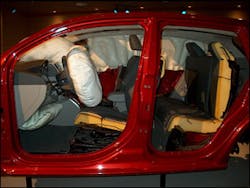Body structural components in the Caliber form a structural safety-cage for occupant protection in the event of an impact.
Dodge has introduced a new vehicle with the 2007 model year; the Dodge Caliber. The Caliber is a five-door hatchback roughly the size of a Neon which it essentially is replacing in the Ford lineup. As such, the Caliber is considered a compact SUV.
For this Crash Course drill, we will review the airbag systems that are present on this vehicle as standard equipment. Have your crew visit a new car dealership to view this vehicle and become familiar with its' design features and safety equipment.
The front structure of Caliber is composed of three key crush zones designed to absorb as much of an impact as possible. An energy-absorbing steering column and steering wheel add further protection.
Body structural components in the Caliber form a structural safety-cage for occupant protection in the event of an impact. The cage helps to shield occupants by managing and controlling energy away from the interior occupant area.
The Caliber, which is built in Belvedere, Illinois, comes standard with frontal airbags and roof airbags. The cut-away model displayed at auto shows in late 2005 also showed a driver's knee bag. Dodge refers to this safety feature as their inflatable knee blocker.
The driver and front passenger airbags are Next Generation multistage front airbags that sense the severity of the impact and inflate with different levels of force. This means that a deployed airbag could deploy a second time during your EMS or extrication work if you do not shutdown the vehicle's electrical system.
As is normal, the driver's side air bag is housed in the steering wheel hub and the front passenger air bag is concealed behind a blow-out panel in the upper portion of the instrument panel.
A supplemental side curtain airbag is also standard. Dodge refers to this as a "front and rear air bag" because it is long enough to deploy and protect the second row seat passengers in the event of a side collision. The stored gas inflator is mounted low along the inside of the rear C-pillar, almost below the rear speaker deck area.
Note that the passenger's frontal airbag extends beyond the windshield opening. This indicates that during an actual deployment, the airbag will inflate into the windshield glass and then deploy rearward to protect the front passenger.
Crash Course Teaching Point: Side curtain airbags and knee bags are becoming more and more common. They can be present in any vehicle regardless of its size or shape, make or model. Expect that roof and knee airbags are there until proven otherwise.
Be Informed...Be Ready..Beware!






